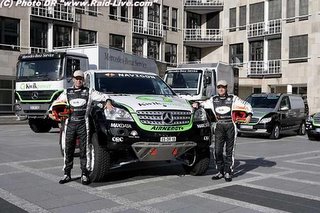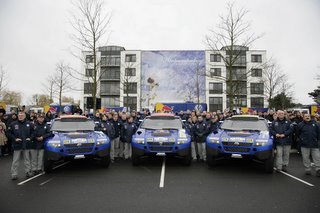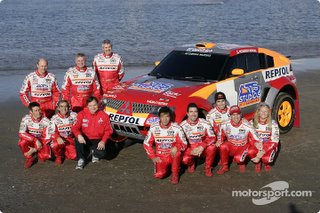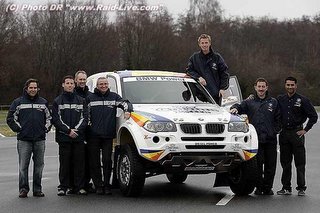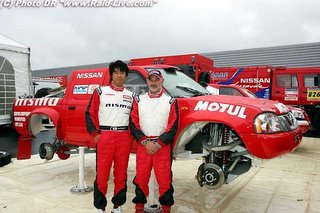

 Trucks, (T-4 Class)
Trucks, (T-4 Class) The trucks are the work horses of the event. In order to keep the crews in reach of their teams the chase vehicles are entered in the Dakar Rally as well. They provide support on the race course for both cars and bikes while they battle for their own title. They transport tires, mobile workshops, tools, spare parts not limited to transmissions, suspension parts, camping gear and even yes, toilet paper. Whatever your driver may need it is on the way. There is several options for teams with the support race trucks. The top teams have team owned and entered trucks and many additional trucks have leased space onboard that support many different teams from one truck. Trucks fall under the T-4 classification and maintain a separate set of regulations. Team Gordon has chosen not to enter their support trucks and have leased space with a top T-4 team. This will allow Team Gordon to keep their support team in top form for the two week event; keeping maximum effort focused on the H-3 weapon.
The present technical regulations govern competitions between 2 to 4-axle trucks. With the exception of the authorized modifications specified in these regulations, the vehicles must comply with a FIA homologation form for Group T4. Optional equipment or additional accessories which do not modify the vehicle's performance are authorized.
Eligible vehicles Series production 2- to 4-axle trucks (chassis-cab) produced by a recognized constructor, with a permissible total laden weight of minimum 3,500 kg and fitted with conventional bodywork are eligible. The competitor is responsible for providing all the proof requested by the scrutineers, such that they may check that the submitted vehicle is or has been produced in series and that it is on normal sale to the public, and is homologated in Group T4.
SAFETY REQUIREMENTS Roll cage Cab: An internal cab roll cage must be fitted. The basic purpose of such a roll cage is to protect the driver and passengers if the vehicle is involved in a serious accident. In addition to the internal roll cage, it is permitted to fit an external roll cage, subject to the following conditions: To the front, no part of the cage may extend beyond the projection of the base vehicle over the ground. No part of the external cage may project beyond the side and the upper extremities of the load-bearing bodywork of the base vehicle. To the rear, no part of the external cage may be located more than 0.5 meters behind the back of the bodywork of the cab.
Load-bearing bodywork: The rear part of the vehicle (the part intended to carry the merchandise) must be reinforced in front (the panel of the bodywork situated behind the cab) by a completely closed roll bar ABCD made rigid by a diagonal AD or BC which must follow exactly the contour of the inside of the bodywork and its minimum height must be at least equal to that of the highest part of the cab or of its external roll bar (air intakes and exhaust outlets are not taken into consideration).
Cab and bonnet lock down Vehicles with tilt cabs must have an additional device which bridges the normal tilt lock mechanism and will prevent cab tilt in the event of that mechanism disengaging. It must be fixed between the chassis and the safety cage or the cabin.
Propeller shaft For each longitudinal transmission shaft over 1 m long, a roll bar or a safety loop made from steel must be installed close to the front extremity.
Wheels and tires The size of the rims is limited to 14 x 20 inches and the total diameter of the wheel when mounted and inflated to 5 bar must not exceed 1300 mm. Split rim wheels are forbidden. It is prohibited to fit any spacers or adaptors between the road wheels and the hub.
Wheel nut covers: Wheel nut covers must be fitted to all wheels if nuts or studs extend beyond the complete wheel.
Wheel balance weights It is prohibited to have removable balance weights fitted to any wheel.
Tires Any tire which the scrutineers consider to be dangerous or in breach of the regulations, for one reason or another, shall be refused.
Spare wheel/tire: Two wheels or two tires, depending on the type of wheels used, are compulsory.
Windscreen and body glazing All window operating mechanisms must function as designed by the manufacturers (e.g. manufacturers' wind-down windows must remain as wind-down windows).
Steering lock Any steering lock system fitted to the vehicle may be removed.
Windscreen wiper and washer All vehicles must be fitted with at least one windscreen wiper and a washer. These must be maintained in a working condition at all times.
Warning triangle This is compulsory, in case of a breakdown or an unscheduled stop. The triangle must be placed on the track, in such a way that it is clearly visible, 100 m before the immobilized vehicle.
Rear view mirrors It is permitted to fit additional rear view mirrors, but the standard mirrors must be retained and kept in working order, at all times.
CHASSIS
Only local modifications of the chassis frame are permitted in order to comply with the safety requirements described in art. 3 of these regulations.
With the exception of the items covered in art. 7.1, the chassis frame must be exactly to manufacturer's standard specification. Manufacturers' options on chassis shape and material are prohibited.
BODYWORK
Cab interiorDoor locks must be kept in the unlocked position while the vehicle is on the route.
Seats The occupants' seats may be removed.
Trim Carpet and floor coverings may be removed. Any loose floor coverings must be removed.
Steering wheel A non-standard steering wheel of proprietary manufacture may be fitted.
Pedals The pads of the pedals may be modified as long as this does not involve any lessening to their resistance.
Additional accessories All those which have no influence on the vehicle's behavior, for example equipment which improves the aesthetics or comfort of the cabin (lighting, heating, radio, etc.), are allowed without restriction. In no case may these accessories increase the engine power or influence the steering, transmission, brakes, or road holding, even in an indirect fashion. All controls must retain the role laid down for them by the manufacturer. They may be adapted to facilitate their use and accessibility, for example a longer handbrake lever, an additional flange on the brake pedal, etc. Insulating material may be added to the existing bulkheads to protect the passengers from fire.
Cab exterior
Mudguards All vehicles must be equipped with mudguards on the rear wheels. They must have no sharp edges and must cover the full width of the tire over a continuous arc of 120°. This minimum coverage must be achieved with a continuous surface of rigid material uninterrupted by any gaps, holes, slots or vents. The mudguards must extend forward of the relevant axle centre line in vertical projection. The trailing edge of the mudguard must be no higher than the top of the corresponding rim. The front mudguards will remain those of the cabin of the homologated vehicle.
Winches Only winches, fitted without making any modifications to the structure of the vehicle other than a modification allowing the winch to be attached by means of bolts, are authorized.
Load-bearing bodywork
Outside Only load-bearing bodywork homologated as an Option Variant (VO) is authorized.
Inside The transporting of "merchandise" is entirely the responsibility of the competitor. However, the Scrutineers may check the quality of the load, with regard to safety. The transporting of certain quantities of dangerous materials is governed by official regulations. Any dangerous liquids must be held in tanks similar to those of the vehicle (FT3 1999 safety tank or truck tank).
ENGINE
General With the exception of permitted modifications detailed there under the engine and all ancillaries must be exactly to manufacturer's standard specification.
Engine speed Maximum engine speed may be changed.
Water cooling system The original number of water cooling radiator units must be retained. They must be fitted to their original mounting points on the chassis. However, it is permitted to change the size and shape of these radiators, and associated piping, as long as this does not cause any change in body or chassis shape.
Air induction system The air filter(s) and tubing upstream of it (them) may be modified. No part of the air induction system may project more than 300 mm beyond the side or top extremities of the cab.
Fuel injection system Only the settings on the fuel injection pump may be modified.
Exhaust After the final muffler, the exhaust pipe may be modified. A vertical exit pipe or two at the most, may be installed. The fitting of a particulate filter is authorized but must be submitted to the Homologation and Technical Working Group of the FIA beforehand for approval, with the presentation of a technical dossier drawn up by the manufacturer of the vehicle.
SUSPENSION
Dampers A maximum of four damper units are allowed per axle. Their make and type are free, but they must have no other function than that of dampers. If hydraulic damper units are used, there must be no interconnection between the circuits. The damper supports are free on condition that they have no other function than that of support.
Rigid axles may be strengthened, but in such a manner that the original parts may be recognized. The addition of a reinforcing bar between the front axle and the chassis is authorized.
Springs The number of spring leaves is free.
Travel limitation Travel straps may be fitted. The suspension travel is limited to 300 mm.
TRANSMISSION
Clutch The clutch plates are free.
ELECTRICS
Lighting system All lamps required for normal legal road use must be functional at all times and must not be concealed. The number of headlamps is limited to 8. They must be fitted in accordance with the International Road Traffic Convention, at a maximum height not exceeding that of the lowest part of the windscreen. No lamp other than those provided for by the International Road Traffic Convention and the present regulations may be fitted.
Batteries Vehicle batteries must be to original specification or equivalent. They must not be positioned inside the cab. They must be securely fastened, each battery to be held down by at least two steel bolts of 10 mm minimum diameter. They must be protected to prevent short circuiting of terminals. Batteries must not be visible from outside the vehicle.
BRAKES
Braking system The entire braking system must remain original (except for art. 5.1.1.6 - Pedals). The material and attachment system of the brake linings are free.
WHEELS
Specification These must be of unmodified proprietary manufacture and must be such that no part of a rim or tire fouls on any part of the vehicle under extremes of steering or suspension movements. The wheel nuts and studs must match the wheel rims being used, to ensure adequate fixing strength. Wheel nuts must be of unmodified proprietary manufacture.
Rim dimensions Maximum allowed wheel rim width is 14". Different rims from the original ones may be authorized by the supplementary regulations of the event, according to the type of terrain.
Wheel track and vehicle widthThe combination of axles and wheels/tires fitted must not cause the vehicle width to exceed 2,500 mm, nor increase the front or rear wheel track by more than 150 mm beyond manufacturer's standard specification.
TIRES
Specification Maximum permitted section width: 19". All tires fitted to the vehicle must have a tread depth complying with relevant national legal requirements for the duration of the event. Re-cut and/or hand grooved tires are not permitted. Tires fitted must be available through normal retail outlets for all weather use on roads and/or tracks. Special tread compounds and/or patterns are not allowed, nor are any externally applied chemical compounds which may affect tire grip. All tires must have a speed index of "F" or more. No carcass may have undergone serious repairs.
Inflating / Deflating The use of a system for inflating / deflating the tires when rolling the vehicle is in motion is authorized.
VEHICLE WEIGHT
The minimum allowed vehicle weight at any time is the weight of the vehicle, emptied of fuel, without persons, luggage, tools, jack, spare parts, portable survival, navigation or communication equipment, provisions, etc., but with the safety devices, and its bodywork as defined here above. It must not be less than the weight of the chassis-cab homologated, modified by the multiplicating coefficient 1.33.
FUEL TANK
Type Additional fuel tanks are free in respect of capacity. They must be of unmodified proprietary manufacture, of a type normally used in
trucks
Additional tanks (Other than those feeding the vehicle) No reserves containing fuel may be situated on the outside of the vehicle (jerry cans or other cans). Containers for water or lubricants will be tolerated on the outside of the vehicle, must be firmly secured and must not project beyond the perimeter of the vehicle.
TACHOGRAPHS
The tachographs record vehicle speed. Competitors are reminded that any change to the vehicle which may affect the calibration of the tachograph (e.g. a change of tire make or tire size) must be approved by the Scrutineers. It is specifically forbidden to conceal, or interfere in any way with, the approved tachograph or any associated wiring, cable drive or sender units. If any change is made to the vehicle specification which may affect tachograph calibration, or if the system is interfered with in any way, it is the competitor's responsibility to have the tachograph recalibrated and re-certified. Failure to comply with this requirement may cause the vehicle to be rejected at Scrutineering. Competitors are reminded that tachographs are extremely accurate measuring devices.









